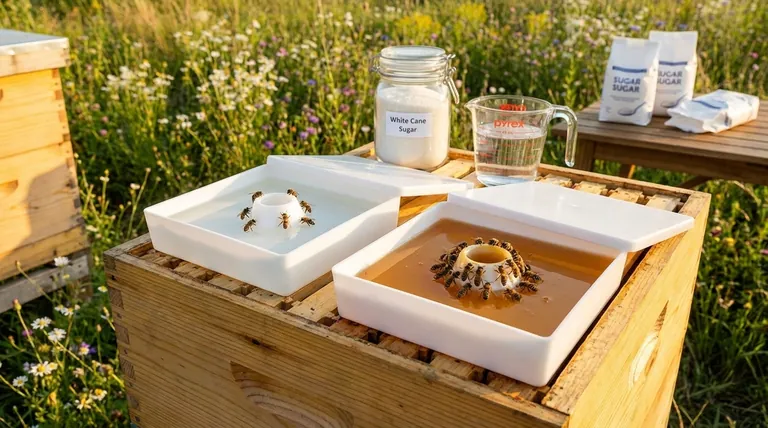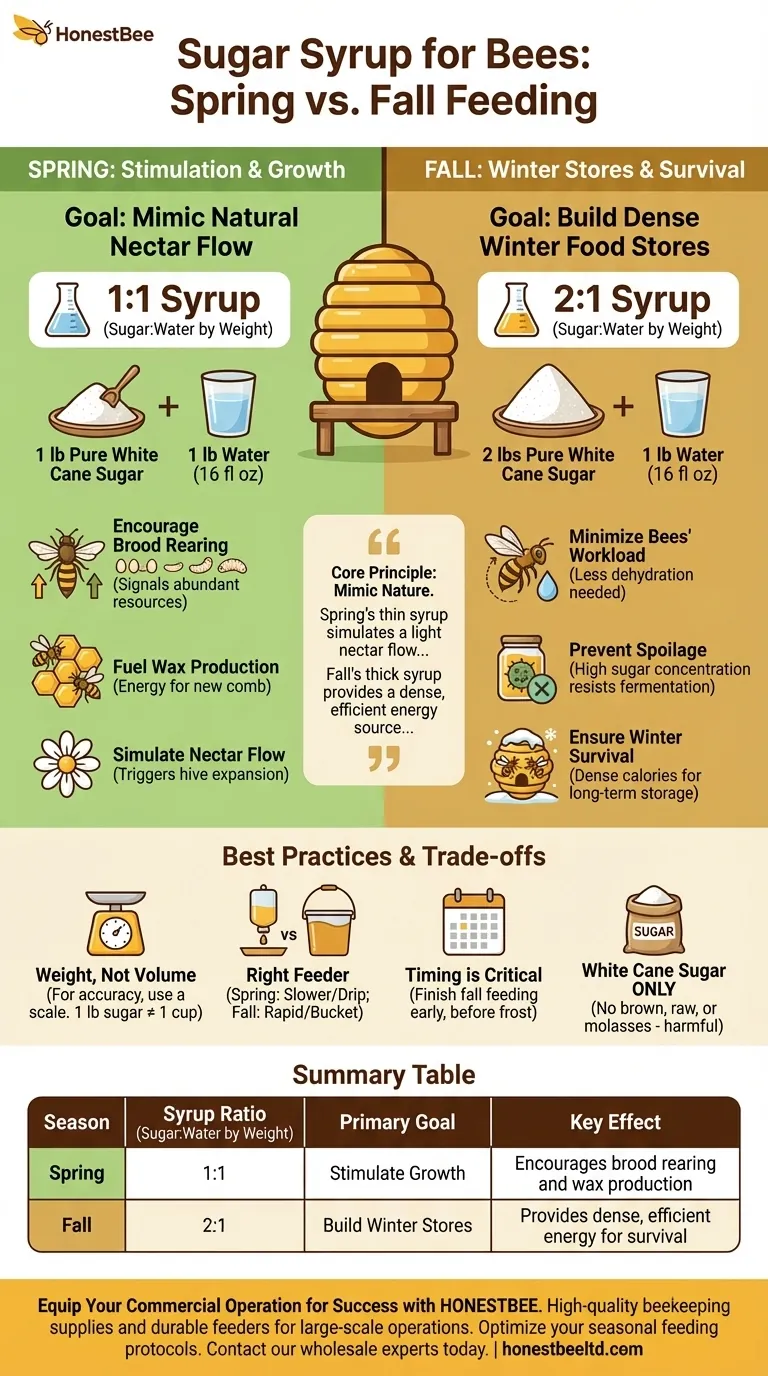The correct sugar syrup for feeding bees depends entirely on your seasonal goal. For spring, you should use a thin 1:1 syrup (one part sugar to one part water by weight) to stimulate growth. For fall, you must use a thick 2:1 syrup (two parts sugar to one part water by weight) to build winter food stores.
The core principle is to mimic nature. Spring's thin syrup simulates a light nectar flow, encouraging the queen to lay eggs and the colony to expand. Fall's thick syrup provides a dense, efficient energy source that bees can easily convert into honey for winter survival.

The Purpose of Spring Feeding: Stimulation
The goal of spring feeding is not to produce honey, but to encourage the rapid build-up of the colony's population. You are providing fuel to energize their natural spring instincts.
Mimicking a Natural Nectar Flow
A 1:1 syrup has a sugar concentration very similar to that of natural flower nectar. This signals to the bees that a nectar flow has begun, triggering a cascade of expansion activities within the hive.
Encouraging Brood Rearing
This simulated nectar flow is a primary signal for the queen bee. It tells her that abundant resources are available, making it safe to begin laying large numbers of eggs to grow the workforce for the main summer honey flow.
Fueling Wax Production
Young worker bees require a significant amount of carbohydrate energy to produce beeswax. The 1:1 syrup provides the cheap, accessible fuel needed to draw out new comb for the expanding brood nest and for future honey storage.
The 1:1 Ratio Explained
To make spring syrup, combine one part pure white cane sugar with one part water by weight. For example, you would use 1 pound of sugar for every 1 pound (which is 2 cups or 16 fluid ounces) of water.
The Purpose of Fall Feeding: Winter Stores
Fall feeding has a completely different and more urgent purpose: ensuring the colony has enough stored food to survive the long, cold winter when no natural forage is available.
Creating Dense, Efficient Food
A 2:1 syrup is a heavy, supersaturated solution. Its high sugar concentration provides maximum calories with minimal water content, which is exactly what bees need for long-term storage.
Minimizing the Bees' Workload
Before storing syrup, bees must dehydrate it to a moisture content below 18% to prevent fermentation, just as they do with nectar to make honey. Because 2:1 syrup starts with far less water, the bees expend significantly less energy fanning their wings to cure it. This is critical in the fall as the colony's population is shrinking.
Preventing Spoilage
The high sugar concentration of 2:1 syrup is less prone to fermentation and mold, both in the feeder and during the initial storage process within the hive.
The 2:1 Ratio Explained
To make fall syrup, combine two parts pure white cane sugar with one part water by weight. For example, you would use 2 pounds of sugar for every 1 pound (2 cups) of water.
Understanding the Trade-offs and Best Practices
Simply knowing the ratios is not enough. Proper feeding technique is crucial for hive health and avoiding unintended consequences.
Always Use Weight, Not Volume
For accuracy, always measure your ingredients by weight. A pound of sugar takes up less space than a pound of water, so measuring by volume (e.g., one cup to one cup) will result in an incorrect, weaker syrup.
Use the Right Feeder for the Season
In the spring, a slower feeder like a frame feeder or an entrance feeder that mimics a slow "drip" is ideal for stimulation. In the fall, a rapid feeder like a top feeder or bucket feeder allows the bees to quickly move large quantities of thick syrup into the hive for storage.
Timing is Critical
Fall feeding must be completed early enough for the bees to process the syrup before cold weather arrives. A good rule of thumb is to finish all fall feeding by the end of September or at least a few weeks before your first frost.
Use Only White Cane Sugar
Never use brown sugar, raw sugar, molasses, or other sugar syrups. These contain solids and compounds that bees cannot digest, which can lead to dysentery and kill the colony over the winter.
Matching Your Syrup to Your Seasonal Goal
Your choice of syrup ratio should be a conscious decision based on what your colony needs at a specific time of year.
- If your primary focus is stimulating spring growth: Use a thin 1:1 syrup to encourage the queen to lay and workers to build comb.
- If your primary focus is building winter food stores: Use a thick 2:1 syrup to provide dense calories that bees can easily process and store with minimal effort.
By aligning your syrup ratio with the bees' seasonal needs, you become a more effective and responsible steward of your hive.
Summary Table:
| Season | Syrup Ratio (Sugar:Water by Weight) | Primary Goal | Key Effect |
|---|---|---|---|
| Spring | 1:1 | Stimulate Growth | Encourages brood rearing and wax production |
| Fall | 2:1 | Build Winter Stores | Provides dense, efficient energy for survival |
Equip Your Commercial Operation for Success
As a beekeeper or distributor, the right feeding strategy is critical for hive health and productivity. HONESTBEE supplies the high-quality beekeeping supplies and equipment—including durable feeders and more—that commercial apiaries and distributors rely on for efficient, large-scale operations.
Let us help you optimize your seasonal feeding protocols. Contact our wholesale experts today to discuss your specific needs and ensure your colonies thrive year-round.
Visual Guide

Related Products
- HONESTBEE Professional Hive Top Bee Feeder Feeding Solution
- Rapid Bee Feeder White Plastic 2L Round Top Feeder for 8 or 10-Frame Bee Hives
- HONESTBEE Round Hive Top Bee Feeder for Syrup
- HONESTBEE Entrance Bee Feeder Professional Hive Nutrition Solution for Beekeeping
- Professional Hive Top Bee Feeder for Beekeeping
People Also Ask
- What is the best way to top feed bees? A Safe, High-Volume Feeding Solution for Your Apiary
- What are the advantages of hive top feeders? Maximize Feeding Efficiency for Your Apiary
- What features make top feeders a reliable choice for beekeepers? A Guide to Safe, Efficient Hive Nutrition
- What safety features are included in top feeders? A Guide to Drowning Prevention and Hive Safety
- What should be done with feeders and equipment after feeding bees? Essential Steps for Apiary Health



















